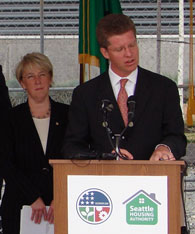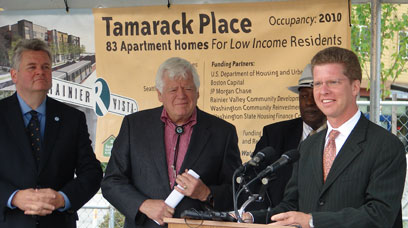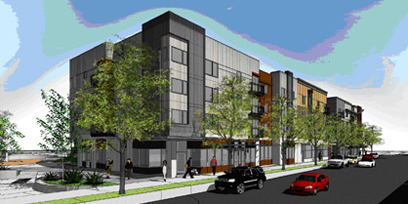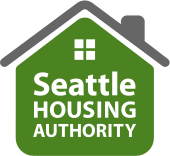 Senator Patty Murray with HUD Secretary Shaun Donovan.
Senator Patty Murray with HUD Secretary Shaun Donovan.SEATTLE—August 10, 2009—U.S. Department of Housing and Urban Development Secretary Shaun Donovan, Senator Patty Murray and Congressman Jim McDermott joined Mayor Greg Nickels, local housing staff and residents on Monday, August 10 to mark the start of construction for Tamarack Place and the resumption of redevelopment work in the Rainier Vista neighborhood in Southeast Seattle.
Construction on the 83-unit mixed-use low-income housing building will begin this month. The northern portion of the site will also come alive with bulldozers and construction workers as infrastructure work begins there. Thus, Monday’s event celebrated the re-start of construction at Rainier Vista as a whole, made possible by $13.5 million in funding from the American Recovery and Reinvestment Act.
In February 2009, HUD Secretary Donovan announced over $3 billion in Recovery Act funds to be allocated by formula to housing authorities nationwide. SHA funneled a majority of its $17 million share to the Rainier Vista project, which had been stalled by difficult development conditions.
 Mayor Greg Nickels, Congressman Jim McDermott and Resident Ed Frazier listen as HUD Secretary Donovan addresses a groundbreaking crowd of 200 on Aug. 10.
Mayor Greg Nickels, Congressman Jim McDermott and Resident Ed Frazier listen as HUD Secretary Donovan addresses a groundbreaking crowd of 200 on Aug. 10."The work restarting at Rainier Vista is another example of the investments we are making to build affordable housing in America, create jobs and grow local economies," said HUD Secretary Donovan. "The Seattle Housing Authority, and this development, are a model of the effective use of Recovery Act funds, creating as many as 350 jobs for local residents while building sustainable and affordable homes and a whole new community. I want to thank Senator Murray, Congressman McDermott and Mayor Nickels for their leadership in getting these Recovery dollars spent effectively and quickly."
“This money provides a missing link that allows us to continue fulfilling the promise of Rainier Vista,” explained Seattle Housing’s Executive Director Tom Tierney. Over $7 million will fund construction of Tamarack Place; $6.5 million will fund infrastructure on the northern portion of the site.
“Today we are starting another chapter in the success story that is Rainer Vista,” said Senator Murray. “And as Rainer Vista continues to be transformed, so do the lives of the people that live there. Rainier Vista is a great example of a community that brings together all kinds of families, and offers them a stable and secure place to call home. It’s also an example of Recovery Act money being used to create jobs and improve local economies.”
 View of Tamarack Place from the Northwest
View of Tamarack Place from the NorthwestRepresentative Jim McDermott praised the redevelopment as an example of what can be achieved with collaboration, saying, “Rainier Vista is a shining example of what it means to live in a community and a country that defines itself by the common good, by using the word “we” much more than using the word “me.”
Progress on Rainier Vista’s renewal has been hampered by unfavorable development conditions, including factors that limited buildable space on the site and the overheated construction costs created by the housing bubble. Work was stalled as the mix of private and public funding was disrupted. The bond and low-income housing tax-credit markets dried up with the nationwide economic slowdown, and the housing crisis lowered land values.
With the funding allocation announced in February 2009, the Recovery Act reignited progress with $13.5 million of new investment. “This funding allows us to make up for the loss of funds caused by the economic downturn. Now we can take advantage of reduced construction costs to complete this much-needed affordable housing,” explained SHA Senior Housing Developer Rebecca Whitney.
Tamarack Place is a mid-rise mixed-use building incorporating green design features. The 83 residential units will have water-conserving plumbing fixtures, ENERGY STAR appliances and high-efficiency lighting fixtures, formaldehyde-free composite wood, and low VOC paints and adhesives. Passive solar considerations were included in the design of the building, providing an open floor plan for optimization of daylight penetration and passive ventilation. While solar panels are not currently planned, the roof will accommodate them in the future and will feature areas of vegetated covering.
The overall redevelopment project includes many other sustainable design considerations, such as construction material recycling, street and sidewalk designs that encourage non-automobile transportation, reduction of runoff and protection of an existing wetland.
The Rainier Vista redevelopment is transforming the former public housing site into a mixed-income neighborhood for more than 850 diverse households. Affordable rental housing is available for low- and very low-income residents, as well as those who are able to purchase market-rate homes. Seattle Housing Authority invested in a completely new infrastructure grid to allow the community to connect with the surrounding neighborhoods and take advantage of the adjacent Link light rail station.
Rainier Vista is also home to community resources including the recently opened Boys & Girls Club and the Neighborhood House Rainier Vista Center. Open space, public art, playgrounds and ball fields are among the amentities in this new, livable neighborhood, close to downtown. Housing for seniors and the disabled is provided by Providence Health & Services, Housing Resources Group and Building Changes.
The first phase of the Rainier Vista redevelopment began with a $35 million federal HOPE VI grant in 1999. As the project has progressed, about 45 percent of the $240 million total project budget has come from a mix of government sources, such as tax-credit financing and bond sales, while 55 percent has been made up of investments by private and nonprofit housing developers.
The 481 original worn-out housing on site was designed as worker housing during World War II. Preceding Phase I demolition in 2003, public housing residents on site received relocation assistance, assurances of replacement housing and an opportunity to return to the new Rainier Vista when complete. By 2005, residents who were originally relocated began moving back into new affordable rental apartments. Alongside them, families were able to purchase market-rate housing completed in 2006. The completion of Phase I paved the way for work on Phase II to begin in 2006.
SHA is currently applying for additional money for Rainier Vista through a competitive funding round that is part of HUD's continuing distribution of the Recovery Act funds.
